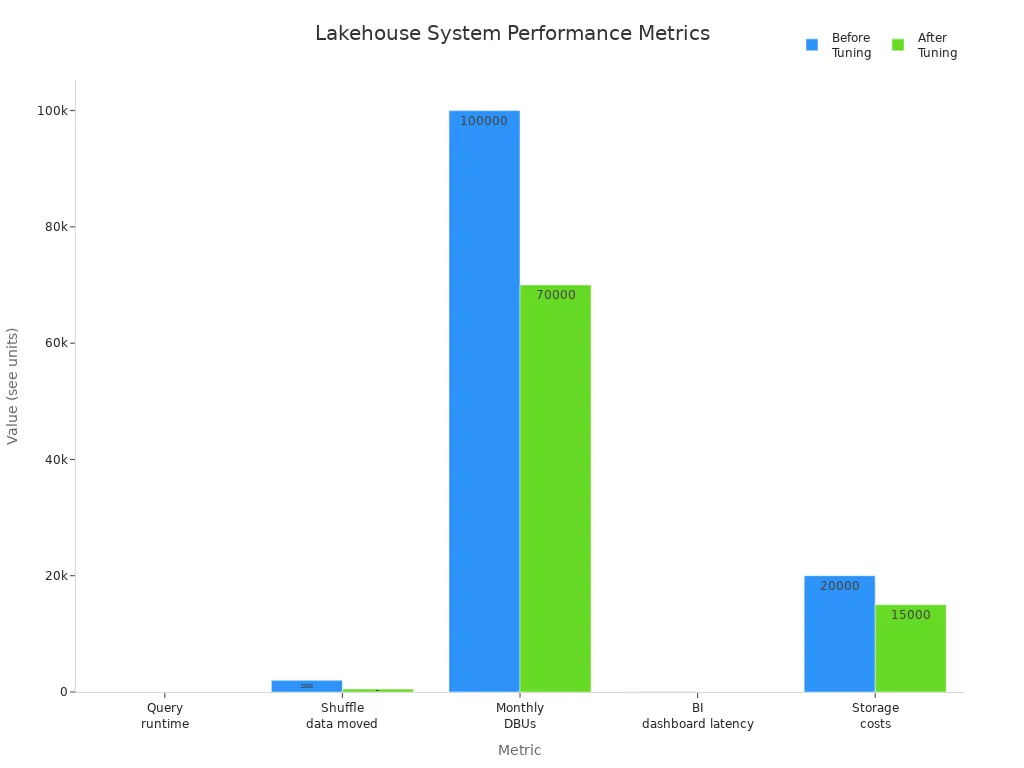What Is a Lakehouse and Why Does It Matter?

You use a Lakehouse when you want a mix of data lake and data warehouse features. A Lakehouse lets you keep your data in open formats. It works with many types of data, like structured and unstructured. You get safe transactions, good schema management, and built-in data rules.
More than half of companies already use Lakehouse platforms for most analytics, and this number is rising.
Description | |
|---|---|
Open Data Architecture | Keeps data in open formats, so different engines can run many types of analysis. |
Support for Varied Data Types | Handles structured, semi-structured, and unstructured data for many kinds of analysis. |
Transactional Support | Gives ACID guarantees for transactions, so data stays reliable and consistent. |
Less Data Copies | Cuts down on extra copies by letting you use data straight from open storage formats. |
Schema Management | Makes sure data follows a set schema and helps the schema change over time. |
Data Quality and Governance | Uses tools for keeping data correct, following rules, and meeting laws like GDPR. |
Key Takeaways
A lakehouse mixes the best parts of data lakes and data warehouses. It lets you keep and study all kinds of data in one spot. Using a lakehouse saves time and money. You do not need many systems or extra copies of data. Lakehouses help with advanced analytics and machine learning. You get answers faster without moving your data. Lakehouses have strong tools for rules and data quality. These tools make sure your data is good and follows the rules. Many industries use lakehouses. They help with things like tracking inventory, caring for patients, and finding fraud.
Why Lakehouse Matters

Business Impact
You want your business to make good choices fast. A lakehouse helps by mixing data lake and warehouse features. You can keep raw data like a data lake. You also have neat, organized data for reports like a warehouse. This lets you use information quickly and in many ways.
You can study both structured and unstructured data together.
You do not need extra copies of your data, so you save time and money.
You can do many kinds of analysis, from simple reports to deep insights.
Many companies have seen big improvements with lakehouses. For example, a regional insurer made processing 45% faster and got better at audits. A global retailer made better forecasts and spent less on inventory. Healthcare providers report faster and use AI to find new ideas.
Organization Type | Measurable Benefit |
|---|---|
Regional Insurer | Processing is 45% faster and audits are easier |
Global Retailer | Forecasts are better and inventory costs are lower |
Healthcare Provider | Reports are faster and AI finds new insights |
You save money because you do not need many systems. Lakehouses let you keep all your data in one place. This means you spend less on storage and running things. You can also avoid being stuck with one vendor, so you have more choices later.
Lakehouses fix big data problems for businesses:
Data Challenge | Description |
|---|---|
Disconnected Systems | Important data is stuck in different places, so you do not see the whole picture. |
Diverse Data Types | Old systems cannot handle both structured and unstructured data well. |
Growing Complexity | Too many transactions and formats are hard for old solutions to manage. |
Many industries use lakehouses for better results. Healthcare uses them to study patient records and device data. Finance uses them to make smarter investments. Retailers learn more about customers and manage stock better. Manufacturers improve production, and governments make better policies.
Data Science and ML
You want to do more than just make reports with your data. A lakehouse lets you use advanced analytics, data science, and machine learning (ML) without moving data around. This makes your work faster and easier.
You can reach all your data in one spot, so you do not waste time moving files.
You can run machine learning models right on your data, which speeds up your work.
You can use tools that help with every step of ML projects, from training to deployment.
You can use deep learning and GPU acceleration for tough AI jobs.
"A data lakehouse lets you do advanced analytics and machine learning on the platform, so you do not need to move data. This helps you build and use AI models faster and get more value from your data."
Lakehouses help keep your data clean and ready to use. They check for errors automatically, so you spend less time fixing mistakes. You can work in the cloud or across clouds, which gives you more choices for speed and safety.
E-commerce companies use lakehouses to mix customer browsing data with inventory info. This helps them make shopping personal and predict stock needs in real time. You can do this too, using all your data to make better choices and build better products.
Lakehouse vs Data Lake vs Warehouse
Key Differences
You might ask how a lakehouse is different from a data lake or a data warehouse. Each one works with data in its own way. The table below shows what makes them different:
Feature | Data Warehouse | Data Lake | Data Lakehouse |
|---|---|---|---|
Data Type | Cleaned and processed | Raw, native format | Structured, semi-structured, unstructured |
Analytics Tools | Built-in engines | Needs external tools | Built-in, better for AI/ML |
Storage Cost | High for performance | Low, flexible, scalable | Low cost with management |
Transaction Support | ACID transactions | No ACID support | ACID transactions |
Use Cases | BI and analytics | Diverse data formats | BI, predictive analytics, AI, ML |
Data Processing | ETL | Needs external processing | ETL or ELT |
Data Handling | Batch | Batch and streaming | Batch and streaming |
A lakehouse mixes the best parts of both systems. You can keep all kinds of data together. You get strong rules and fast ways to study your data. You do not have to move data between places, so you save time.
Data warehouses are good for business reports but need clean data.
Data lakes hold lots of raw data but do not have strong rules or fast searches.
Lakehouses let you use all your data for many jobs, like machine learning and real-time checks.
Lakehouses use smart ways to organize and find data. This helps you get answers faster than with data lakes. You can work with both batch and streaming data, so you get results quickly.
Unique Benefits
Lakehouses give you special benefits. These help you fix problems that older systems cannot solve.
Unique Benefits of Lakehouses | Description |
|---|---|
Support for Structured and Unstructured Data | You keep all your data types in one spot. |
Advanced Analytics Capabilities | You can make reports and build AI models on the same system. |
Real-Time Processing | You study data as soon as it comes in, which helps with supply chain and customer needs. |
Unlimited Storage | You can keep adding data without limits. |
Metadata Storage Options | You can get to your data easily for different apps and users. |
Stores use lakehouses to watch inventory in real time. This helps you make better ads and help customers faster.
Hospitals mix patient records with sensor data. You get quicker answers and better care.
Banks find fraud fast by checking thousands of events every second.
Walmart made its data fresher and made pipelines five times faster with a lakehouse. Robinhood grew its data system and followed strict rules like GDPR, all without making new systems.
You get a system that is flexible and strong. It grows with you. You can use smart tools, save money, and make better choices every day.
Lakehouse Features
Unified Storage
Unified storage lets you keep all your data together. You can work with text, images, and numbers in one spot. You do not need to switch between platforms. This makes it faster to get your information. It is also easier to control your data.
Evidence | Explanation |
|---|---|
Unified storage brings different data types together | You can use many formats from one place. |
Good metadata management helps you find things fast | The system organizes data so you find it quickly. |
Handles batch and streaming data | You see new data right away and study it as it comes. |
Central rules keep data safe | You follow rules and keep your data trustworthy. |
ACID transactions keep data correct | Your data stays reliable every time you use it. |
Tip: Unified storage stops confusion and saves you time. You do not have to move files between systems.
Open Formats
Open formats make sharing and studying data easy. These formats work with many tools and systems. You are not stuck with one vendor. You have more choices for your data.
Open Format | Benefits |
|---|---|
Delta Lake | Works with Databricks, keeps data safe, and lets you see old data. |
Apache Hudi | Handles lots of changes, connects with Spark, Flink, Presto, and Trino. |
Apache Iceberg | Reads data fast, lets you change structure, and keeps versions. |
You can manage data across different systems.
You can use new analytics and reach your data from anywhere.
Note: Open formats help you use new tools and keep your data ready for the future.
Performance
You want your system to be quick and dependable. Lakehouse platforms use smart tech to make analytics and transactions faster. You can run SQL queries on all kinds of data and get answers fast.
Technology | Role in Performance |
|---|---|
Postgres | Handles transactions and gives real-time analytics. |
Lakehouse | Manages analytics and helps with data science. |
Open Table Formats | Lets you study big datasets with control. |
You get strong support for safe transactions.
You use less storage and spend less money.

The chart shows that tuning a lakehouse system makes queries four times faster. It also cuts dashboard wait times by 80%. You save money on storage and resources.
Lakehouse Challenges
Implementation
Setting up a lakehouse can be hard. The process is tricky if you do not have enough tech skills. You must handle many types of data and make sure they work together. Sometimes, metadata is not the same everywhere, so it is tough to organize and find data. You also have to follow strict laws like GDPR and HIPAA, which makes moving data harder.
You may have trouble with unified metadata standards.
You must follow local laws.
You need to deal with the tech challenges of building a lakehouse.
You must keep your data safe and secure.
Some groups worry about vendor lock-in with special cloud services. You might see query speed change, so it takes longer to get answers. Developers need to know the file system behind the lakehouse, which adds more steps.
You can beat these problems with smart plans. The table below lists some good solutions:
Strategy | Description |
|---|---|
Lakehouse Catalog | Tracks and manages tables for better organization and access. |
Automated Maintenance | Removes manual steps and streamlines data management. |
Centralized Governance | Keeps access controls consistent and improves security. |
High-Performance Analytics | Uses federated queries for faster results across datasets. |
Enhanced Consistency | Ensures unified data definitions for reliable insights. |
Tip: You can get lakehouse benefits right away during migration by using these plans.
Governance
You need strong governance to keep your lakehouse safe and trustworthy. Good governance helps you keep data quality high, follow rules, and protect privacy. You must set clear rules for handling data, so your insights are more reliable.
Data governance keeps your data reliable and easy to reach.
You must follow laws like GDPR and HIPAA.
You need to keep privacy and security all the time.
A detailed plan helps you track how you use and store data. This plan keeps you safe from legal trouble and builds trust with customers and partners. You should learn about data protection rules and industry standards. Regular checks help you avoid fines and keep your data safe.
You can use tools to make governance easier:
Dremio gives you a central place to organize and govern data.
dbt (Data Build Tool) lets you change, test, and write about data for consistency.
Great Expectations helps you check data quality with rules.
Note: Strong governance in your lakehouse helps you make better choices and keeps your group safe from risks.
Lakehouse Architecture

A Lakehouse has many important parts. These parts help you use and manage your data. Each part does a special job. The table below shows the main components:
Component | Description |
|---|---|
Data Storage Layer | Keeps all raw data, like files and images, using cloud storage. |
Data Ingestion Layer | Collects data from places like APIs and databases. |
Data Processing Layer | Gets data ready for study with real-time and batch jobs. |
Metadata Layer | Tracks schema, data history, and rules for good data. |
Data Consumption Layer | Lets people use data with tools such as Tableau and Power BI. |
Storage Layer
You put all your data in the storage layer. This layer holds files, images, logs, and tables. Most lakehouses use cloud storage. Cloud storage is cheap and grows easily. You get ACID transactions here. You can update, delete, or merge data safely. This keeps your data safe and easy to manage. Open table formats help you organize files.
Tip: The storage layer gives you strong database tools and saves money.
Metadata
Metadata is like a map for your data. It tells you what each file is and how it fits with other data. You use metadata to find and understand your data fast. It helps keep your data clean and current. Metadata rules let you change your data’s structure when needed. Automated checks use metadata to find mistakes or missing pieces. A data catalog stores all this info, so you always know what you have.
Metadata helps you track changes and keep data quality high.
It sets rules for who can see or change data.
You can use metadata to manage data from many sources.
Processing
You need to turn raw data into answers. The processing layer does this work. It handles real-time streaming and batch jobs. You can use it for quick tasks, like spotting fraud, or big jobs, like making reports. Lakehouses work with tools for analytics and machine learning. This means you get insights faster and make better choices.
Real-time processing helps you react fast to new data.
Batch processing lets you handle lots of data at once.
You can connect to analytics and AI tools for deeper insights.
Note: The processing layer gets your data ready for action, now or later.
You can change things easily and keep data safe.
You use all kinds of data, like tables and files.
You get quick answers and can use AI and machine learning.
You spend less money because you only need one system.
You can add more data as your business gets bigger.
Lakehouses mix the best parts of data lakes and warehouses. You keep, organize, and study data faster and better.
More companies are picking lakehouses, so you will find new ways to use data and help your business grow.
FAQ
What is the main benefit of a lakehouse?
You get one system for all your data. You can store, manage, and analyze different types of data together. This helps you save money and work faster.
Can you use a lakehouse for machine learning?
Yes, you can. You can train and run machine learning models right on your data. You do not need to move data to another system.
Is a lakehouse hard to set up?
You may find setup tricky if you do not have experience. Many tools and guides can help you. Start small and add more features as you learn.
How does a lakehouse keep data safe?
Lakehouses use strong rules and controls. You can set who sees or changes data. The system checks for errors and follows privacy laws.
See Also
Exploring Why Lakehouses Are Essential in Modern Data Management
Comparing Apache Iceberg And Delta Lake Technologies
Enhancing Dataset Freshness By Linking PowerBI With Singdata Lakehouse
How Iceberg And Parquet Revolutionize Data Lake Efficiency
Understanding OLAP Cubes And Their Significance In Analytics

